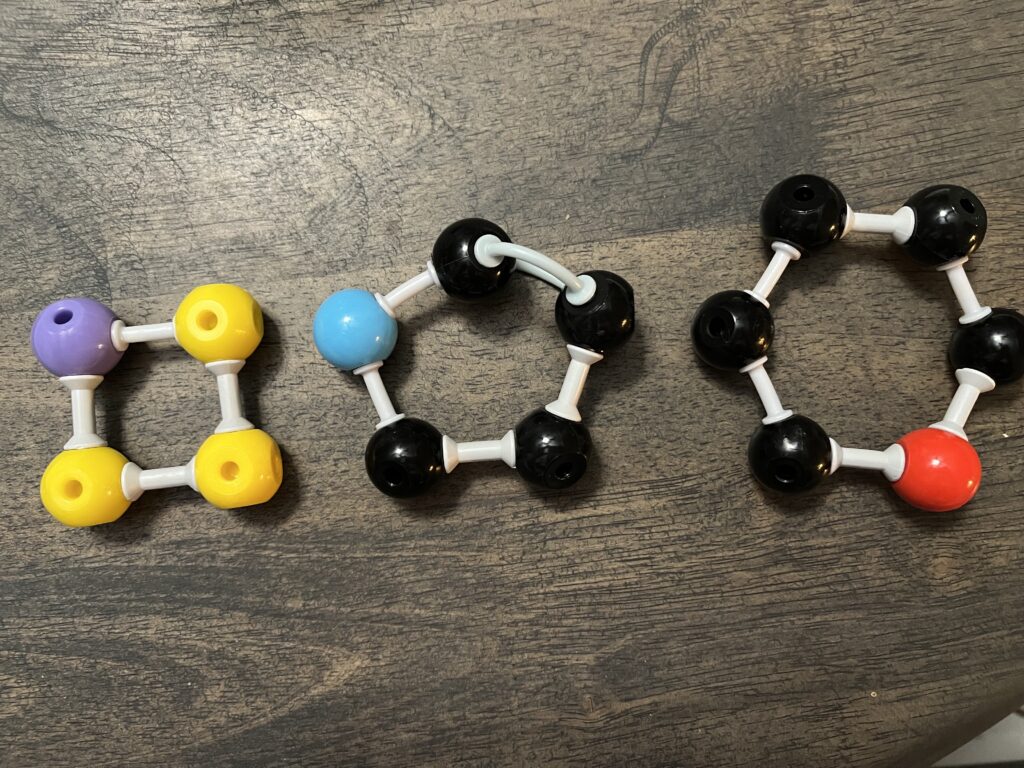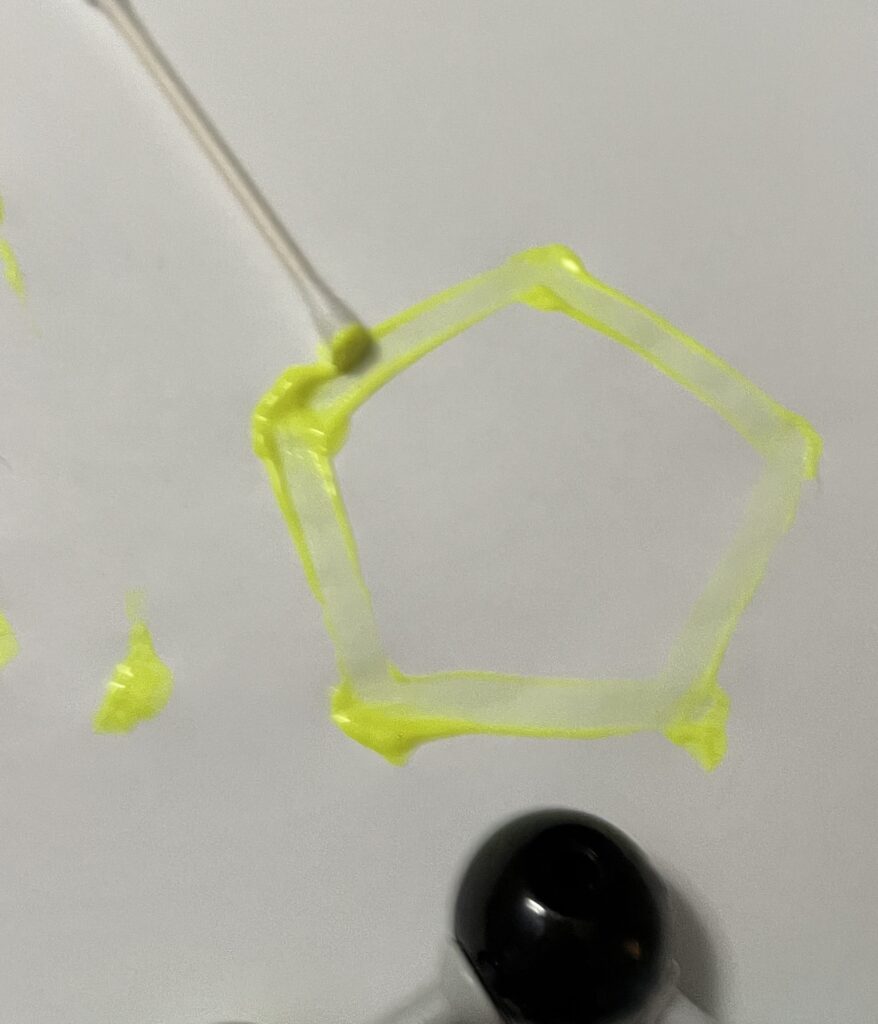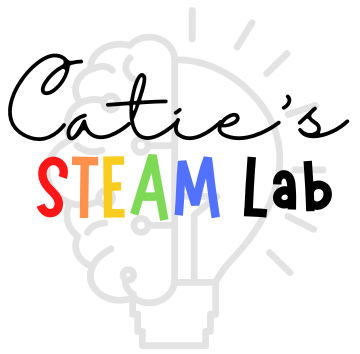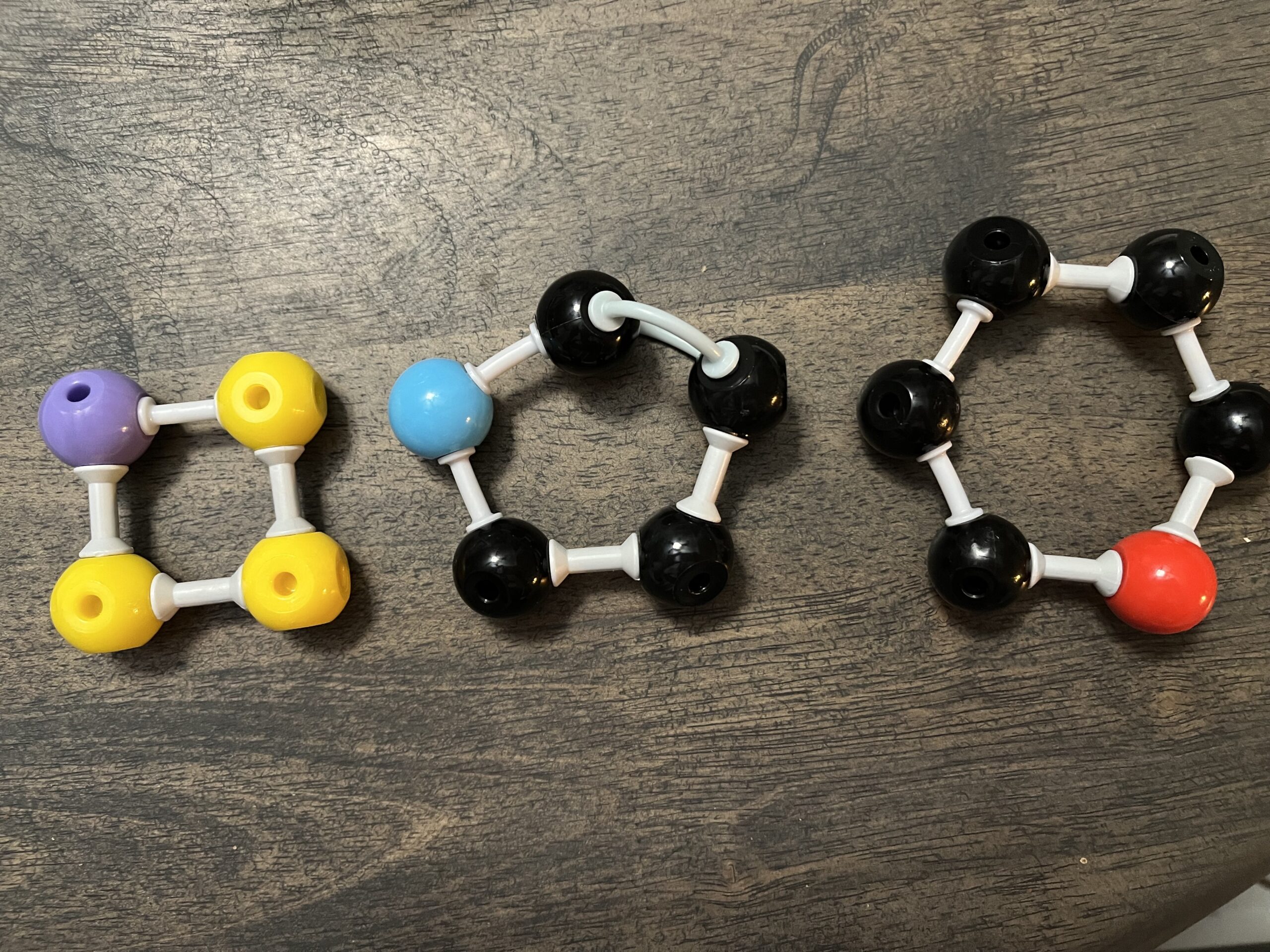On my most recent trip to the bookstore, I was on the hunt for a new book for Evie. I stopped in my tracks when I reached one book that was going to teach my daughter organic chemistry. It was awfully cute. They turned molecules into balls and showed the different ways that molecules connect together. All of the sudden, a lightbulb went off in my head! What a wonderful shape STEAM lab for kids!
I won’t lie it brought memories from my days in organic chemistry. The ONLY reason I survived that class was my model set. WARNING! NERD ALERT! Did you know that molecules arrange themselves very geometrically? Hexagons and pentagons are seen throughout organic chemistry because it provides the molecule some stability, meaning they do not react as easily. Triangles are not seen in organic chemistry frequently. They create angles that do not promote stability and therefore they will react more readily.

Anyways…this book got me thinking…I have my molecule kit stashed away somewhere. I wouldn’t want Evie playing with it yet…those pieces are small! However, they made great shapes for my classroom! Using my molecule kit, my geometric shape STEAM Lab was born! I was able to discuss different shapes with my classroom. We counted the atoms and how many sides each molecule had. I absolutely love introducing this vocabulary and you better believe that any time we do coffee filter art projects I introduce some other big fancy chemistry words!
Molecule Shapes: Connecting the Dots at Home
While we were doing our lesson, I had some different ideas on how to incorporate more art into our math and science lesson. We used our molecules as stamps! Yes. My molecule set needed DEEP cleaning afterwards, but I believe that it was completely worth it! Stamping the molecules onto the paper, my students learned that their molecules only left dots on their papers! This gave us the opportunity to play connect the dots!

Now, I promised an easy at home shape activity and I promise you it is! If you don’t have a molecule set don’t worry! You don’t need to rush out and track one down! There are a couple of different adaptions that you can do! Two simple ways to do this activity without a molecule kit are, marshmallows and toothpicks, or tape and cotton swabs! My favorite alternative is the marshmallow and toothpick route. The marshmallows leave better dots for your child to connect.
Shape STEAM Lab Materials
This post may contain affiliate links, which means I’ll receive a commission if you purchase through my links, at no extra cost to you. Please read full disclosure for more information.
These items can be gathered throughout your home!
- Cotton Swabs and marshmallows (or)
- Toothpicks and tape (or)
- Molecule kit
- Washable paint
- Paper
Other things that you can use:
- Marker
- Laminated shape cards
Age Modifications
18-month-old
For Evie, my 18-month-old, we used the marshmallows and toothpicks…as you may have guessed, she ate the marshmallows before we got to the painting portion, so we scraped the painting today! Instead, I created different marshmallow shapes, and I would give her one shape at a time. I would name the shape and encourage her to repeat the name. Sometimes she would try and get a letter sound down. We are still working on her language skills. Every little sound is an accomplishment! When we say triangle and she repeats the ‘ta’ sound. We praise her because we know she is trying!
2-year-old
For this age, I would start to let your child explore painting. I know, the MESS! But I 100% believe that it is worth it! However, if we use the stamping and connecting the dots method, that I used with my 3.5-year-olds, a 2-year-old may take their cotton swab and smear paint like Pollock or Picasso. Giving a reminder, ‘just a dot, not a lot’ will go a long way in containing the mess! Creative painting isn’t always a bad thing, but if your goal it for your child to start developing the fine motor skills, writing skills and building those muscles in their hands, I would recommend having pre-drawn lines on the paper. This way your child can use the line as a guide, paint dots on the line or trace the line with paint! This can be done with a marker on paper or laminated shape cards! I love these shape cards. They are a great way to introduce a color lesson in this activity. When you laminate the cards, it makes clean up so easy! I cleaned mine with a little bit of water and baby soap! The washable paint comes right off and then they are ready for use again!
5+ years old
For children that are a little bit older, this is a great introduction to fractions! For example, you can ask your child or help your child build triangles with cotton swabs and tape. Ask them if they can build a hexagon with a triangle. Can they build a pentagon? How many triangles would it take to make a hexagon, a pentagon? If they use stamps and connect the dots, can they create lines within their shapes to create other shapes? Making this connection between shapes and the angles they are creating will be a great foundation for this introduction later in their math career!
STEAM Lab Integration
Math
This activity is a great activity for strengthening a child’s number sense. Counting the sides of the shapes will also help a child independently distinguish between shapes like a hexagon, octagon, and pentagon. All these shapes look similar and having a child count the shapes will help them learn the difference between them. Introducing fractions can also strengthen the math aspect of this activity.
Art
Creating an opportunity for a child to use their creative minds will allow your child to explore new ideas that they may not have thought of before. I have noticed this with my students who have started to draw lines between dots. Not only can they connect the dots, but they can create geometric images with the stamps. Encourage your child to try to create a picture, a dog, a tree, or whatever they are interested in, with only the shape stamps. Engage your child where he or she already wants to be! If they like cars, try making a car with their shapes. Count the number of triangles, squares, or hexagons it took to make their image!
Final Thoughts
Remember, the important part of a STEAM lesson is the integration of at least two aspects of STEAM; science, technology, engineering, art, and math. These activities and projects typically work best when your child has a problem they need to solve. I encourage you to let them explore. Let your child figure out what the items they have can solve the problem you have presented. Their solutions just might surprise you! Lesson can always be modified for a child! There are multiple ways to accomplish a task, and everyone has their own perspective on how they can complete it! STEAM lessons do not need to be complicated. You don’t need to buy a million things to do them! Most lessons can be done with items that you have in your home! My goal is to help you and your child through your learning journey! How did this activity work for you? Did you make any modifications? Did you child surprise you? Let me know how it went for you! Feel free to comment and share your experience! Thank you all for your support!

